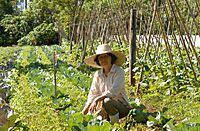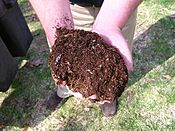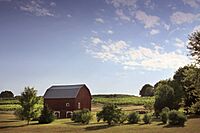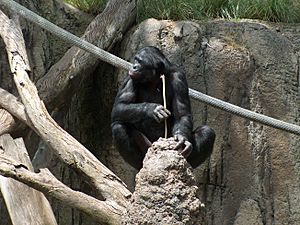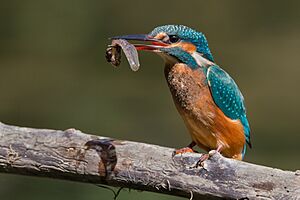Nutrition facts for kids
Nutrition is how living things use food to stay alive and grow. It gives organisms nutrients. These nutrients can be used to make energy and build body parts. If an organism doesn't get enough nutrients, it can suffer from malnutrition. Nutritional science is the study of nutrition, often focusing on how humans get their food.
Different living things need different nutrients and get them in various ways. Some organisms eat other living things. Others use non-living materials or sunlight. Some can even make their own nutrients from basic elements. All life needs carbon, energy, and water, plus other important molecules. Animals need complex nutrients like carbohydrates, lipids (fats), and proteins. They get these by eating other organisms. Humans have learned to farm and cook, which changed how we get our food. Plants get nutrients from the soil and the air. Fungi absorb nutrients from their surroundings by breaking them down.
Contents
History of Nutrition Science
Scientific study of food and nutrients started in the late 1700s. Chemists experimented with different elements and foods. They wanted to understand how nutrition works. Modern nutrition science really began in the 1910s. This is when scientists started finding individual micronutrients.
The first vitamin identified was thiamine in 1926. Vitamin C was found to prevent scurvy in 1932. Over the next few decades, scientists learned a lot about what vitamins do. During the Great Depression and World War II, people worried about diseases from not getting enough food. This led to the first recommended daily amounts of nutrients for humans. Because it's so important for human health, nutrition study often focuses on people and farming.
What Are Nutrients?
Nutrients are substances that give an organism energy and building blocks. They help it survive, grow, and have offspring. Nutrients can be simple elements or complex macromolecules. About 30 elements are found in living things. Nitrogen, carbon, and phosphorus are among the most important.
Macronutrients are the main substances an organism needs a lot of. Micronutrients are needed in very small amounts. Organic micronutrients are called vitamins. Inorganic micronutrients are called minerals.
Cells absorb nutrients and use them in chemical reactions. These reactions create energy and building blocks for the cell. They also build large molecules and cell structures.
How Organisms Get Nutrients
Living things can be grouped by how they get carbon and energy.
- Heterotrophs get nutrients by eating the carbon from other organisms. Animals are heterotrophs.
- Autotrophs make their own nutrients. They use carbon from non-living things like carbon dioxide. Plants are autotrophs.
- Mixotrophs can be both heterotrophs and autotrophs. Some tiny ocean creatures and carnivorous plants are mixotrophs.
- Phototrophs get energy from light, like plants.
- Chemotrophs get energy by breaking down chemicals.
Some organisms, called prototrophs, can make important nutrients from other compounds. Others, called auxotrophs, must eat those nutrients because they can't make them.
What Is a Diet?
The diet of an organism is all the food it eats. A healthy diet makes an organism physically and mentally healthier. It means eating and absorbing enough vitamins, minerals, essential amino acids (from protein), and essential fatty acids (from fats). Carbohydrates, protein, and fat are very important for good quality of life, health, and a long life. Some cultures and religions have rules about what foods people can eat.
Nutrient Cycles
A nutrient cycle shows how non-living materials move through soil, living things, air, or water. They are then exchanged into living matter. Energy flows in one direction, but nutrients cycle around. Important mineral cycles include the carbon cycle, sulfur cycle, nitrogen cycle, water cycle, phosphorus cycle, and oxygen cycle. These cycles constantly recycle nutrients for healthy ecosystems.
Living things and natural processes perform these cycles. They allow essential elements to return to the environment after being used. Without proper nutrient cycling, there could be changes in oxygen levels, climate, and how ecosystems work.
How Organisms Find Food (Foraging)
Foraging is how organisms search for nutrients in their environment. It also includes how they use these resources. Animals and bacteria can move to find food. Plants and fungi grow outwards to find nutrients. Foraging can be random, or it can be systematic, where the organism goes straight to a food source.
Organisms can sense nutrients through taste or other ways. This helps them control how much they eat. Optimal foraging theory is a model that explains foraging. It suggests animals try to get the most nutrients while spending the least time and energy. Some organisms are specialists, eating only one type of food. Others are generalists, eating many different foods.
Not Enough Nutrients (Deficiency)
Malnutrition happens when an organism doesn't get the nutrients it needs. This can be from losing nutrients quickly or not being able to absorb them. Malnutrition can also be caused by other illnesses. When this happens, an organism will use less energy to save its stored nutrients. It will use up its stored energy. Then, it will break down its own body for more energy.
A balanced diet has the right amounts of all necessary nutrients. These amounts change based on age, weight, gender, and how active a person is. Not having just one essential nutrient can harm the body. Too much of a nutrient can also be harmful. Daily Reference Values (DRVs) help most people avoid nutrient deficiencies. DRVs are guidelines for professionals and policymakers. They show the maximum and minimum nutrient intakes for an average person. Food labels also use DRVs to create safe nutrition guidelines.
Nutrition in Different Organisms
Animal Nutrition
Animals are heterotrophs, meaning they eat other organisms for nutrients.
- Herbivores eat plants.
- Carnivores eat other animals.
- Omnivores eat both plants and animals.
Many herbivores rely on bacteria in their gut to break down plant material. Carnivores must eat meat to get certain vitamins their bodies can't make. Animals generally need more energy than plants. The main nutrients animals need are carbohydrates, amino acids, and fatty acids.
All macronutrients (except water) give the body energy. This energy is measured in kilocalories, often called Calories. One Calorie is the energy needed to raise 1 kilogram of water by 1 degree Celsius.
- Carbohydrates store a lot of energy. Animals digest them to get this energy. Plants usually make carbohydrates. Animals get most of their carbohydrates from eating plants. Carbohydrates include sugars and starches. Glucose is the simplest carbohydrate. They are broken down into glucose and are the most common nutrients for plant-eating land animals.
- Lipids provide animals with fats and oils. They don't dissolve in water and can store energy for a long time. They come from many plant and animal sources. Most fats we eat are triglycerides. These are made of glycerol and fatty acids.
- Protein from food is broken down into amino acids. These amino acids are then used to build new proteins. Protein forms cell structures, fluids, and enzymes (which are like biological catalysts). Enzymes are vital for most body processes, like repairing DNA.
Much of animal behavior is linked to nutrition. Migration and seasonal breeding happen when food is available. Courtship displays show an animal's health. Animals learn what foods are good or bad for them. They might avoid foods that made them sick. Some animals, like rats, only try new foods if they lack a nutrient.
Human Nutrition
Early humans foraged for food, just like other animals. But this changed when humans started farming (the Neolithic Revolution). In the 1700s, the Chemical Revolution allowed us to study food nutrients. This led to better ways of food preparation. In the 1900s, new technology allowed mass production and food fortification (adding nutrients to food).
Human behavior is closely tied to nutrition. Humans eat for pleasure as well as for health. The best diet can vary for each person based on their age, background, and health needs.
Humans are omnivores, eating many different foods. Grains and bread have been a key part of human diets since farming began. Early humans hunted animals for meat. Modern humans raise animals for meat and eggs. Animal husbandry also allowed some cultures to drink milk from other animals and make foods like cheese. Humans also eat nuts, seeds, fruits, and vegetables. Access to farm animals and vegetable oils has greatly increased human fat intake.
Humans have developed advanced ways to process food. These methods prevent germs and make food easier to produce. They include drying, freezing, heating, milling, packaging, and refrigeration. Most cultures add herbs and spices to food for flavor. Other additives are used to improve food safety, quality, flavor, and nutrition.
Humans get most carbohydrates from starches in grains. Sugar has also become very important. Lipids (fats) are found in animal fat, butterfat, vegetable oil, and leaf vegetables. They also add flavor to foods. Protein is in almost all foods, as it makes up cell material. However, some food processing can reduce protein. Humans can also get energy from ethanol (alcohol), but it has few essential nutrients and can cause health problems.
For humans, poor nutrition can cause diseases. These include blindness, anemia, scurvy, and cretinism. Too much nutrition can lead to obesity and metabolic syndrome. Other conditions possibly affected by diet include cardiovascular diseases, diabetes, and osteoporosis. Not eating enough can cause wasting (losing weight quickly) or stunting (not growing tall enough) in long-term cases.
Domesticated Animal Nutrition
For domesticated animals like pets, livestock, and working animals, humans manage their nutrition. This is done through animal feed. Fodder and forage are given to livestock. Special pet food has been made since 1860. Research has helped create pet foods that meet all their nutritional needs. Dog food and cat food are well-studied. They usually contain all essential nutrients for these animals. Cats need certain nutrients from meat, like taurine. Large-breed puppies can get too much nutrition if they eat food meant for smaller breeds.
Plant Nutrition

Most plants get nutrients from non-living substances. They absorb them from the soil or the air. Carbon, hydrogen, oxygen, nitrogen, and sulfur are key nutrients. They make up plant material and help enzymes work. Plants absorb these as ions from the soil (like bicarbonate or nitrate) or as gases from the air (like carbon dioxide or oxygen). Phosphorus, boron, and silicon are also used. They are taken from the soil as phosphates or acids. Other nutrients plants use include potassium, calcium, iron, and zinc.
Plants take in essential elements from the soil through their roots. They get carbon dioxide and oxygen from the air through their leaves. In the soil, roots release hydrogen ions. These ions help plants absorb other nutrients attached to soil particles. In leaves, tiny openings called stomata open to take in carbon dioxide and release oxygen. Even though there's a lot of nitrogen in the air, most plants can't use it directly. Bacteria in the soil change nitrogen into forms plants can use.
These nutrients don't give the plant energy. Green plants get energy from sunlight using chloroplasts. They turn sunlight into usable energy through photosynthesis.
Fungus Nutrition
Fungi get energy by consuming outside matter. Most fungi absorb matter through their root-like mycelium. This mycelium grows through the nutrient source. The fungus releases special enzymes to break down the surrounding matter. Then, it absorbs the nutrients through its cell wall.
Fungi can be:
- Parasitic: They attach to and feed on living hosts, like animals, plants, or other fungi.
- Saprophytic: They feed on dead and decaying organisms.
- Symbiotic: They grow with other organisms and exchange nutrients with them.
Protist Nutrition
Protists are a very diverse group of living things. They include all eukaryotes that are not animals, plants, or fungi.
- Algae are protists that can make energy from light through photosynthesis.
- Some protists have mycelium, similar to fungi.
- Protozoa are protists that get food by eating other organisms. Some protozoa use a flagellum (a whip-like tail) to hunt. Others travel as infectious spores to act as parasites.
Many protists are mixotrophic. This means they can get nutrients from both light and by eating other things. They usually rely on one main source but use the other as a backup.
Prokaryote Nutrition
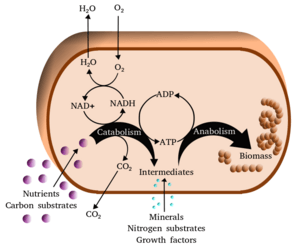
Prokaryotes, which include bacteria and archaea, get nutrients in many ways. Prokaryotes can only take in dissolved substances. But they can break down chemicals around them. Some prokaryotes, called lithotrophs, are extremophiles. They can live in places with few nutrients by breaking down non-living matter.
Phototrophic prokaryotes, like cyanobacteria, can do photosynthesis. They get energy from sunlight. This is common for bacteria that form mats on hot springs. Phototrophic prokaryotes usually get carbon by using carbon dioxide.
Some prokaryotes are predators. They feed on other single-celled organisms. Predatory prokaryotes find other organisms by sensing chemicals or by bumping into them. They then combine with the organism, break it down, and absorb the nutrients. Some attach to the outside of the organism. Others enter its inside or the space around its main cell. Groups of predatory prokaryotes can also work together. They release enzymes to break down other organisms without attaching.
See also
 In Spanish: Nutrición para niños
In Spanish: Nutrición para niños



